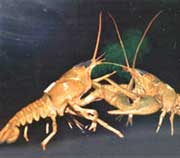Urine trouble

The left-hand crayfish fans green urine at its opponent <br>© T. Breithaupt <br>
A crayfish’s urine scares off its enemies.
A well-timed blast of urine is the key to winning a crayfish fight, say researchers. The chemical aggression intimidates opponents into backing down.
Ecologist Thomas Breithaupt injected freshwater crayfish with a dye that made their urine glow green. He and his colleague Petra Eger staged fights between blindfolded crayfish (Astacus leptodactylus), to replicate the animals’ nocturnal habits1.
The eventual winners were more likely to urinate than the losers. “Urine release is saying ’hey, pay attention: this is a dangerous guy’,” says chemical-communication specialist Jelle Atema of Boston University.
A crayfish smelling another’s urine may be able to gauge its sex, diet, state of health and whether it has recently lost its protective armour by moulting. Only animals in top condition, or those extremely determined to win, can afford to expose their vulnerabilities by broadcasting such signals.
This probably explains why crayfish do most of their urinating in combat situations. “It’s not a good idea to inform your whole social environment about the mood you’re in,” says Breithaupt, who works at the University of Hull.
Crayfish probably also add pheromones to the brew, advertising their strength and aggression, much as deer use their musk glands, says Atema. The exact chemical make-up of the urine is unknown – but Breithaupt hopes to find out.
Fight club
Freshwater crayfish fight a lot. They live in dense groups of up to 20 individuals per square metre, and squabble over food, shelter and mates.
Brawls involve a ritualized escalation of violence – from posturing, to gripping, arm wrestling and finally attempting to wrench each other’s limbs off. Urination increases as the animals become more aggressive, the researchers found.
Chemical signals in the urine tell each party how likely it is to win, reducing the number of extreme fights. If urine release is blocked, fights are longer and more violent.
Crayfish waft the glowing urine towards opponents with their gills. “As far as I know, this is the first time that anyone’s seen chemical communication underwater,” says Breithaupt, although the water probably hums with such messages.
But chemical posturing still needs something to back it up, says Atema, and most encounters do get physical. “Violence is always the reinforcer.”
References
- Breithaupt, T. & Eger, P. Urine makes the difference: chemical communication in fighting crayfish made visible. Journal of Experimental Biology, 205, 1221 – 1231, (2002).
Media Contact
All latest news from the category: Life Sciences and Chemistry
Articles and reports from the Life Sciences and chemistry area deal with applied and basic research into modern biology, chemistry and human medicine.
Valuable information can be found on a range of life sciences fields including bacteriology, biochemistry, bionics, bioinformatics, biophysics, biotechnology, genetics, geobotany, human biology, marine biology, microbiology, molecular biology, cellular biology, zoology, bioinorganic chemistry, microchemistry and environmental chemistry.
Newest articles

“Nanostitches” enable lighter and tougher composite materials
In research that may lead to next-generation airplanes and spacecraft, MIT engineers used carbon nanotubes to prevent cracking in multilayered composites. To save on fuel and reduce aircraft emissions, engineers…

Trash to treasure
Researchers turn metal waste into catalyst for hydrogen. Scientists have found a way to transform metal waste into a highly efficient catalyst to make hydrogen from water, a discovery that…

Real-time detection of infectious disease viruses
… by searching for molecular fingerprinting. A research team consisting of Professor Kyoung-Duck Park and Taeyoung Moon and Huitae Joo, PhD candidates, from the Department of Physics at Pohang University…





















